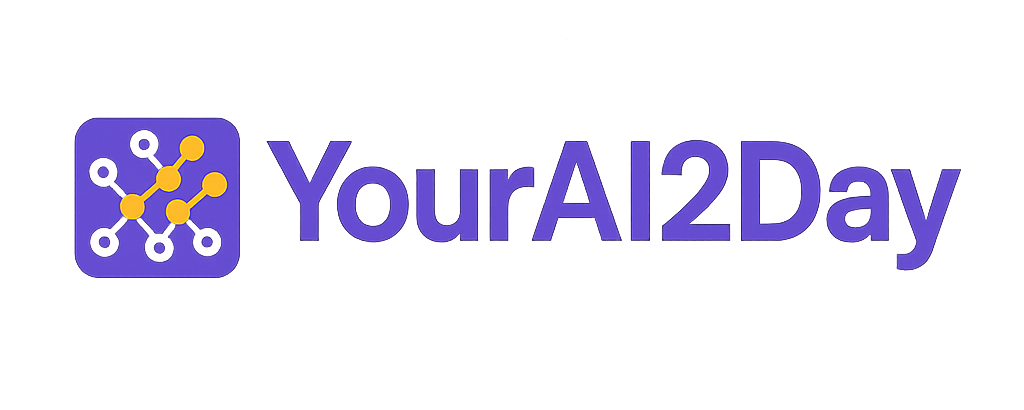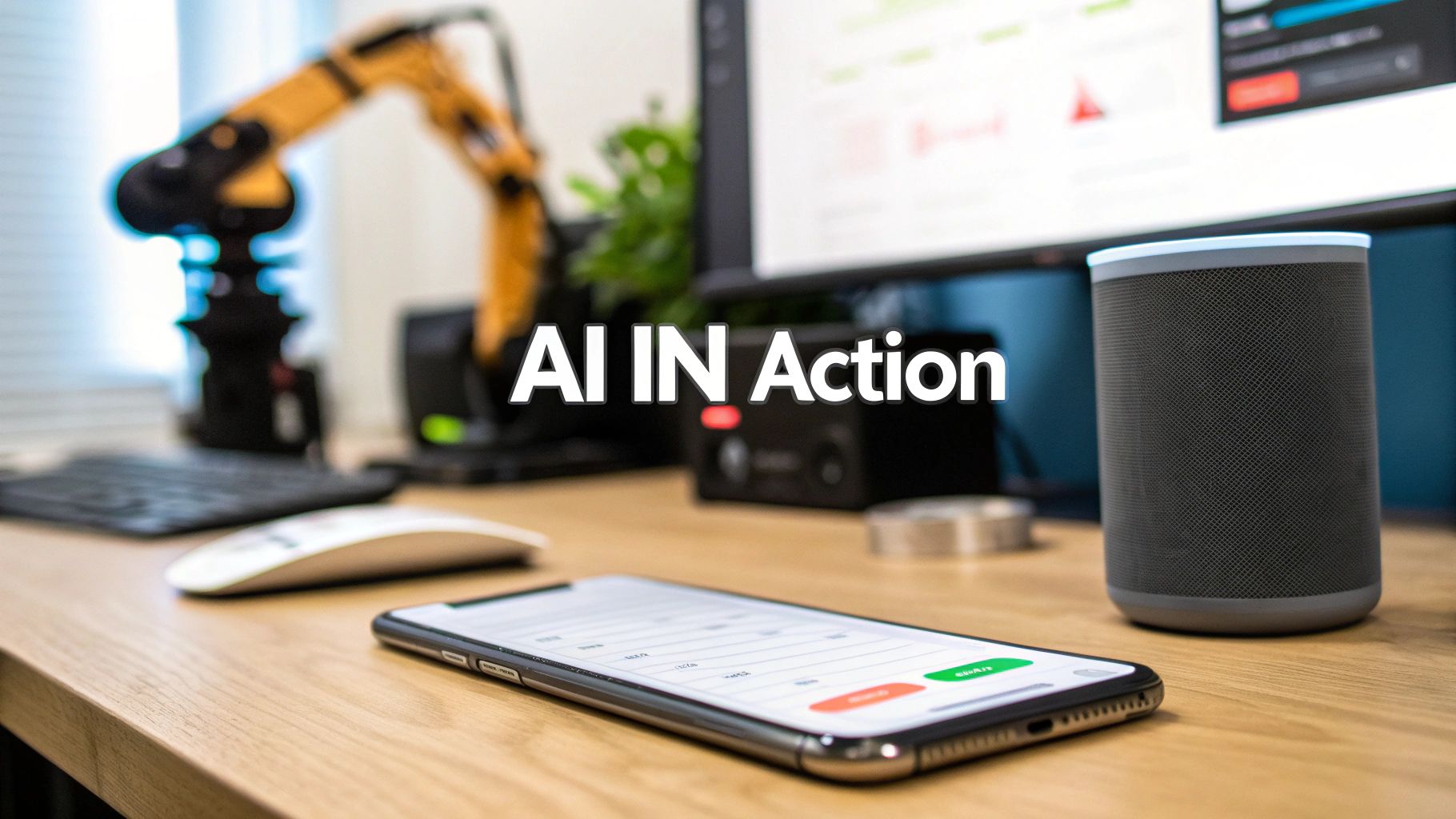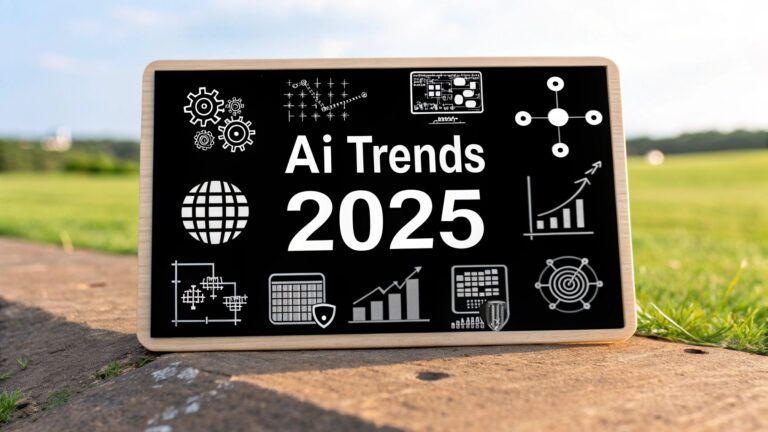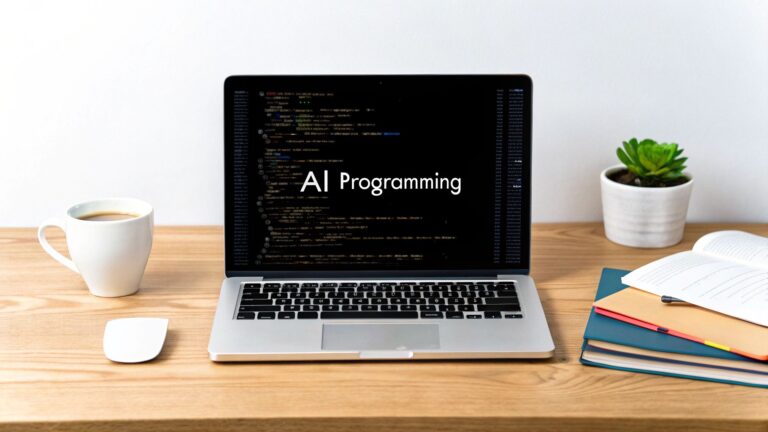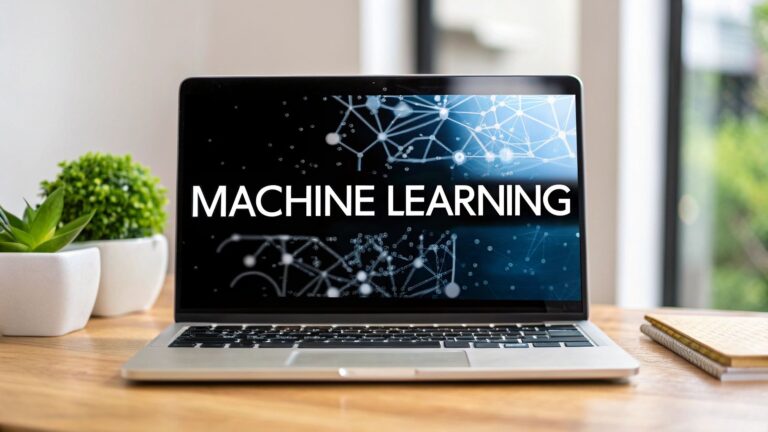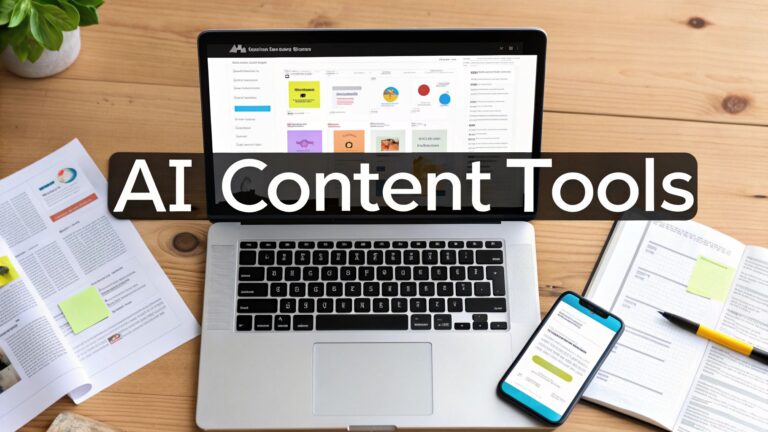10 Practical Applications of Artificial Intelligence We Use Every Day
Ever feel like artificial intelligence is some far-off, sci-fi concept? The truth is, it's already woven into the fabric of our daily routines. It’s the silent partner that helps you dodge traffic, the friendly curator that suggests your next binge-worthy show, and the vigilant guard protecting your credit card from fraud. The term "AI" can sound big and complex, but its real-world impact is simple, practical, and growing every single day. Understanding the practical applications of artificial intelligence is no longer just for tech gurus; it's for anyone curious about how our world works and where it's headed.
This guide is designed to cut through the jargon and give you a clear, friendly look at how AI is actively shaping different industries and our personal lives. We'll skip the generic descriptions and dive into 10 specific examples, from the natural language processing that powers your smart speaker to the computer vision guiding self-driving cars. For each one, we'll look at how it works, share some expert opinions, and offer simple tips you can use.
Forget a dry, technical lecture. Think of this as a behind-the-scenes tour of the AI you're already using. Whether you're a business owner thinking about AI, an entrepreneur looking for inspiration, or just someone who wants to understand the tools in your pocket, this article will give you a solid foundation. Let's explore the intelligent systems that are already here, making our lives a little easier, safer, and more fun.
1. Natural Language Processing in Virtual Assistants
Probably one of the most common and practical applications of artificial intelligence is sitting on your counter or in your pocket right now: virtual assistants. Gadgets like Amazon's Alexa and Apple's Siri rely on a clever branch of AI called Natural Language Processing (NLP). Simply put, NLP gives machines the ability to understand, interpret, and even generate human language. It’s the bridge between how we talk and how computers "think."
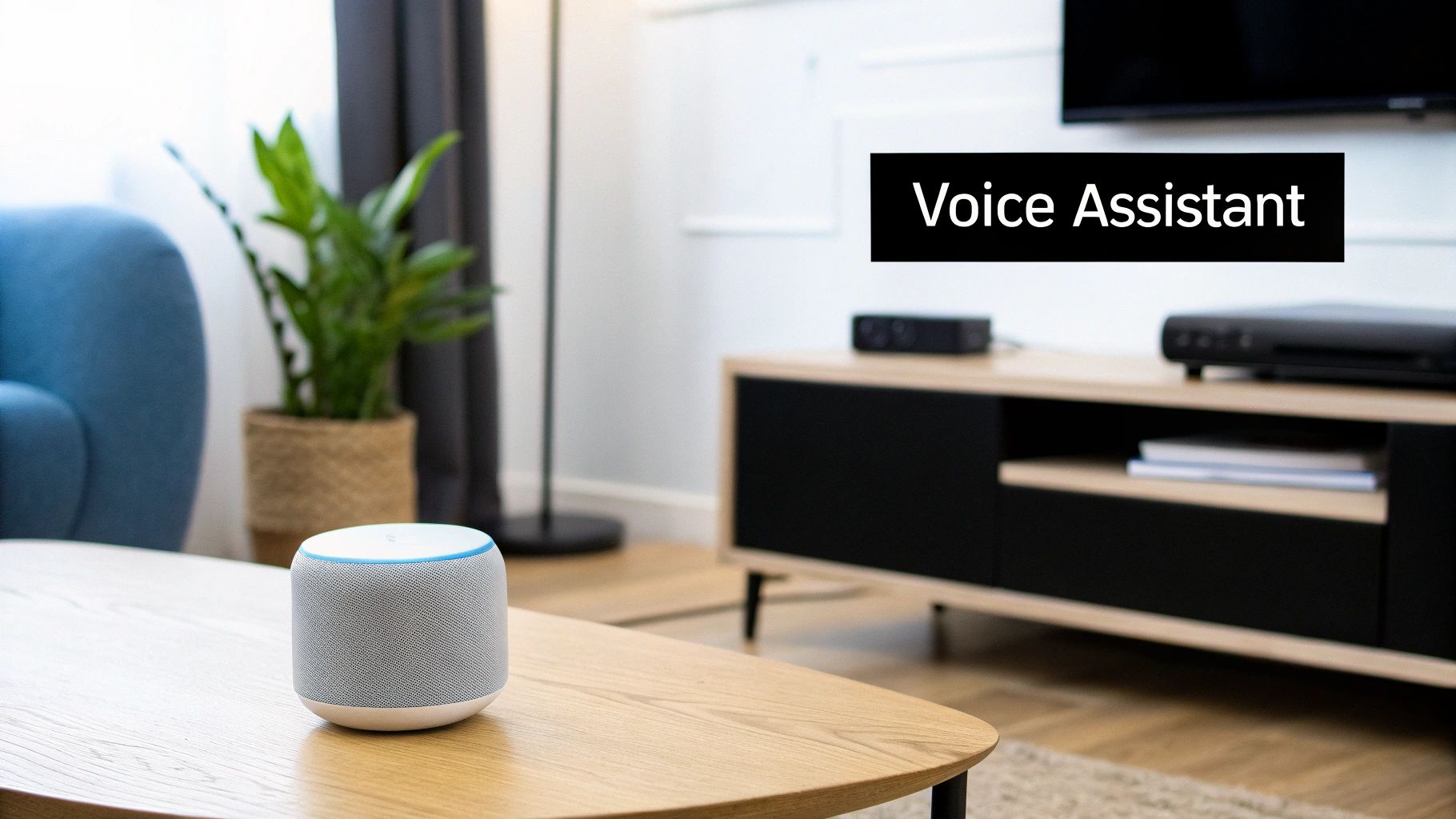
When you ask your smart speaker to play a song or set an alarm, it’s doing more than just recognizing keywords. Powerful AI models are analyzing the grammar, context, and what you actually mean. This is how your assistant knows the difference between "play the next song" and "what's the weather like next Saturday?" and then does the right thing. The AI gets smarter with every question asked, constantly learning our accents, slang, and quirks to become more helpful over time. Think of it as a digital friend who's always learning to understand you better.
Strategic Breakdown
This technology's success comes from how easily it fits into our lives. Companies like Google and Amazon have built entire ecosystems around these assistants, turning a simple voice command into a powerful way to control your smart home, manage your calendar, or get information instantly. This makes them incredibly useful and encourages us to use them every day.
Expert Insight: AI expert Dr. Alistair Finch notes, "The magic of virtual assistants isn't just their ability to understand a command; it's their capacity to learn context from ongoing conversations. This contextual memory is what moves them from simple command-processors to true digital assistants."
Actionable Takeaways for Users
Want to get the most out of your virtual assistant? Try these simple tips:
- Be Specific: Instead of saying "turn on the lights," try "set the living room lights to 50% brightness." The more specific you are, the better the result.
- Integrate Your Apps: Connect your assistant to your calendar, Spotify, and to-do list apps. This turns it into a central hub for your digital life.
- Use Routines: You can create custom routines. For instance, a single "good morning" command could get your assistant to read the news, tell you the weather, and start your smart coffee maker all at once.
Virtual assistants are a perfect example of how NLP makes AI accessible and useful. This same technology also powers more advanced tools, like the best AI writing software.
2. Computer Vision in Autonomous Vehicles
Another of the most mind-blowing practical applications of artificial intelligence is computer vision, the tech that lets self-driving cars "see" and understand the world. Systems like Tesla's Autopilot and Waymo's robotaxis use a mix of cameras, LiDAR, and radar to build a real-time, 360-degree map of their surroundings. This flood of information is then fed into AI models that can spot objects, predict what they’ll do next, and make split-second driving decisions.
When an autonomous car approaches a busy intersection, its AI isn’t just seeing blurry shapes. It's recognizing pedestrians, reading traffic lights, understanding lane markings, and even guessing what other drivers might do. These AI brains are trained on millions of miles of driving data from every imaginable scenario, helping them handle tricky city streets with growing confidence. For example, Waymo's cars have driven over 20 million miles on real roads, constantly learning and improving.
The following infographic highlights key statistics that underscore the scale and impact of this AI-driven revolution in the automotive industry.
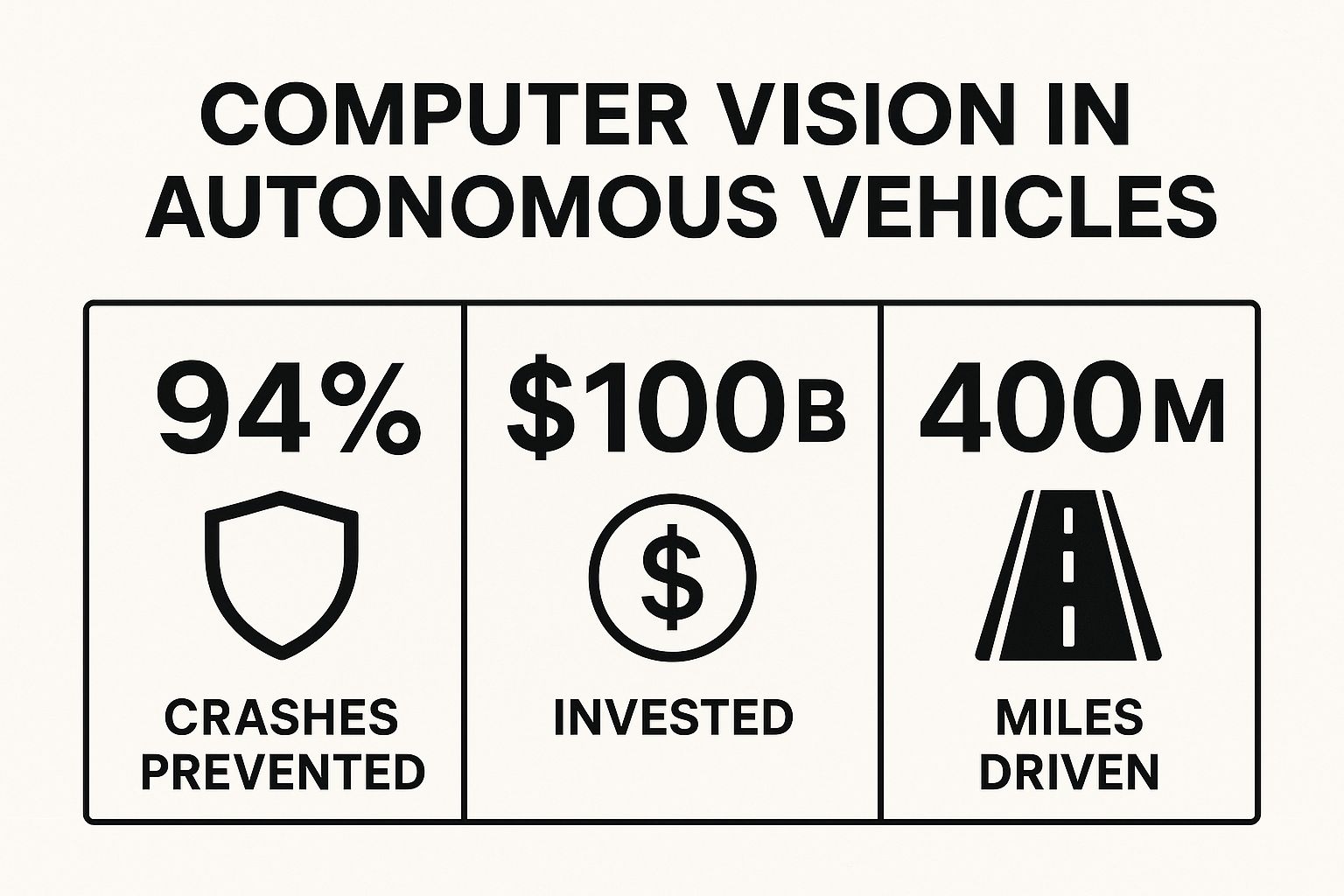
These numbers show just how much effort is going into making our roads safer by reducing human error, which is a factor in the vast majority of accidents.
Strategic Breakdown
The secret sauce for self-driving cars is learning from experience. Every single mile driven by a car in Waymo's or Tesla's fleet sends back valuable data. This data is used to train and improve the central AI models, making every car in the fleet smarter. It’s a powerful feedback loop: the more cars on the road, the faster the AI learns.
Expert Insight: Sebastian Thrun, a pioneer in autonomous driving, often emphasizes, "It’s not about building a car that can follow the rules of the road. It's about building a car that can handle the unexpected, the one-in-a-million event. That requires a level of perception and prediction that only advanced AI can provide."
Actionable Takeaways for Users
If your car has advanced driver-assistance features, these tips will help you use them safely:
- Understand the Levels: Know the difference between driver assistance (like Tesla Autopilot, where you must pay attention) and fully self-driving systems. Always be ready to take the wheel.
- Keep Sensors Clean: Your car's "eyes" are its cameras and sensors. Make sure to wipe off any dirt, snow, or bugs so they can work properly.
- Stay Updated: These systems get better over time. Always install software updates to get the latest safety features and improvements.
3. AI-Powered Medical Diagnosis and Imaging Analysis
AI is making a life-saving impact in healthcare, especially when it comes to medical diagnosis and analyzing images. Think of it as a super-powered assistant for doctors. AI algorithms are trained on huge libraries of medical images like X-rays, CT scans, and MRIs. This training teaches them to spot patterns and tiny details that might be invisible to the human eye, helping doctors make faster, more accurate diagnoses.

For instance, when a radiologist looks at a mammogram to check for cancer, an AI tool can analyze the same image and flag suspicious areas. A practical example is Google Health's AI, which has shown it can detect breast cancer in mammograms with greater accuracy than human experts in some studies. These systems don't just find potential problems; they give doctors data-backed insights to help them make the final call. It’s like having an instant, highly-trained second opinion.
Strategic Breakdown
The goal of AI in medicine isn't to replace doctors, but to give them superpowers. Companies creating these tools focus on fitting them smoothly into a hospital's existing workflow. For example, an AI can flag urgent cases, like a stroke detected on a brain scan, so that the medical team can act faster and save a patient's life. This focus on helping, not replacing, is what makes the technology so valuable.
Expert Insight: Digital medicine advocate Dr. Eric Topol states, "The real promise of AI in medicine is not about replacing physicians, but about providing them with a 'superhuman' ability to see and process information. It's about augmenting intelligence to achieve a higher level of accuracy and efficiency."
Actionable Takeaways for Users
For healthcare professionals looking to use this tech, here are some practical tips:
- Ensure Data Diversity: To work for everyone, the AI needs to be trained on data from a diverse group of patients. This helps avoid biases and ensures it works well for people of all backgrounds.
- Maintain Human Oversight: AI should always be a decision-support tool. The final diagnosis must be made by a qualified doctor who can consider the patient's full story.
- Implement Robust Validation: Before using any AI diagnostic tool in a real clinic, it must be thoroughly tested to make sure it's accurate and reliable.
AI in diagnostics is one of the most important practical applications of artificial intelligence today. You can learn more from leading organizations like Stanford's Human-Centered AI Institute (HAI).
4. Personalized Content Recommendation Systems
Have you ever wondered how Netflix just knows what you want to watch next? That’s one of the most common and practical applications of artificial intelligence at work. Recommendation engines use clever AI algorithms to analyze your behavior, figure out what you like, and suggest content or products you'll probably love. By looking at what you’ve watched, bought, or liked in the past, the AI creates a personalized experience just for you.
When Spotify creates your "Discover Weekly" playlist or YouTube suggests the next video, they're using AI to find patterns. They compare your activity to millions of other users with similar tastes. The result is so effective that it drives a huge amount of what we do online. For example, over 70% of the time people spend on YouTube comes from its recommendations. It’s like having a personal shopper for entertainment.
Strategic Breakdown
The main goal of recommendation engines is to keep you engaged by making it easy to find things you'll enjoy. By constantly serving up relevant content, platforms like Netflix not only keep you watching longer but also make you less likely to cancel your subscription. This creates a powerful cycle: the more you interact, the more data the AI gets, and the smarter its recommendations become.
Expert Insight: Data scientist Dr. Evelyn Reed states, "Effective recommendation engines do more than just match patterns. They create moments of serendipity, introducing users to new content they wouldn't have found on their own but end up loving. This balance between predictable relevance and delightful discovery is the hallmark of a truly intelligent system."
Actionable Takeaways for Users
You can actually help the AI give you better recommendations. Here's how:
- Provide Explicit Feedback: Use those thumbs-up/thumbs-down buttons, star ratings, or "not interested" options. This direct feedback is the clearest signal you can send to the AI.
- Curate Your History: Most services let you remove things from your viewing history. If you watched a movie you hated on a whim, remove it so the AI doesn't think you want more like it.
- Explore Different Genres: Every now and then, watch something completely different. This gives the algorithm more diverse data about your tastes and helps you avoid getting stuck in a "filter bubble."
5. Fraud Detection in Financial Services
One of the most important and practical applications of artificial intelligence is the invisible shield that protects your finances: fraud detection. Banks and credit card companies use AI to sift through millions of transactions in real-time to spot shady activity. The system uses machine learning to understand your normal spending habits—where you shop, how much you usually spend, and what time of day you buy things.
When you swipe your card, the AI instantly checks hundreds of factors. If a transaction looks weird—like a sudden large purchase in a country you've never been to—the system flags it as potentially fraudulent. This is how your bank can send you a text message asking "Was this you?" just moments after a suspicious charge is attempted. Companies like PayPal use this tech to prevent billions of dollars in fraud every year.
Strategic Breakdown
The power of AI in fraud detection is its ability to see subtle patterns that a human would never catch. These systems are also constantly learning and adapting to new tricks that fraudsters come up with. By analyzing millions of data points at once, they can block bad transactions before they even go through, protecting both you and the bank.
Expert Insight: As Nuno Sebastião, CEO of the AI fraud prevention firm Feedzai, often highlights, "The fight against fraud is a constant race. AI gives financial institutions the ability to not just react to threats, but to predict and prevent them by understanding the underlying behavior of both legitimate customers and bad actors."
Actionable Takeaways for Users
While these AI systems work in the background, you can help them protect you better:
- Enable Real-Time Alerts: Turn on transaction notifications from your bank via text or email. This lets you spot and report any unauthorized activity immediately.
- Update Travel Notices: Before you travel, let your bank know where you're going. This helps the AI understand that your purchases abroad are legitimate.
- Use Strong, Unique Passwords: Protect your online financial accounts with good passwords and two-factor authentication. This is your first line of defense, which works hand-in-hand with the AI.
Fraud detection is a great example of AI working behind the scenes to keep us safe. The same analytical power is used in many other areas, and you can learn more about the leading AI data analysis tools.
6. Predictive Maintenance in Manufacturing
One of the coolest practical applications of artificial intelligence is happening inside factories. It's called predictive maintenance. Instead of fixing machines after they break, AI can now predict when a piece of equipment is about to fail. It does this by listening to the machines. Sensors on the equipment constantly monitor things like temperature, vibration, and noise. The AI analyzes this data to find tiny, almost invisible signs of an impending breakdown.
This lets companies schedule repairs before a costly failure shuts down the whole production line. For example, a car factory might get an alert that a specific robot arm is vibrating abnormally, signaling that a bearing is about to wear out. They can then replace the part during planned downtime overnight. This simple switch from reactive to proactive maintenance saves companies millions of dollars and prevents massive delays.
Strategic Breakdown
The big idea here is to use data to move from a "break-fix" model to a "predict-and-prevent" one. By anticipating failures, companies can minimize disruptions, cut maintenance costs, and make their expensive equipment last longer. It turns maintenance from a chore into a smart, strategic part of the business.
Expert Insight: Industrial AI specialist Dr. Lena Petrova states, "Predictive maintenance is the Industrial Internet of Things in action. The real value isn't just the prediction itself, but how it enables an entirely new level of operational planning and resource optimization. It lets you replace a part worth a few hundred dollars before it causes a failure that costs millions in downtime."
Actionable Takeaways for Users
For businesses thinking about using this tech, here are some tips:
- Start with Critical Assets: Begin with the most important machines—the ones that would cause the biggest headache if they broke down. This will show a clear return on your investment.
- Ensure Data Quality: The AI's predictions are only as good as the data it gets. Make sure your sensors are working correctly and collecting reliable information.
- Combine AI with Human Expertise: Use the AI's alerts as a guide, but don't ignore the experience of your veteran maintenance staff. The best results come from combining smart tech with human wisdom.
7. AI-Powered Customer Service Chatbots
Another one of the most practical applications of artificial intelligence that you've likely encountered is the customer service chatbot. These aren't the clunky, frustrating bots of the past. Modern chatbots use conversational AI and natural language processing (NLP) to understand what you're asking, remember past conversations, and provide helpful answers 24/7, often without any human help.

When you visit a website and a chat window pops up asking "How can I help you?", you're probably talking to an AI. These bots can handle thousands of conversations at once, answering common questions like "Where is my order?" or "What is your return policy?" instantly. For example, your energy company might have a bot that can help you submit a meter reading or understand your bill. This frees up human customer service agents to handle more complex or sensitive problems.
Strategic Breakdown
The strategy behind great chatbots is to blend automation with a human touch. The goal is to create a super-efficient first point of contact that can solve most common issues right away. This means shorter wait times for customers and lower costs for the company. The key is to have a seamless handoff: if the bot gets stuck, it should be able to transfer you and the entire conversation history to a real person without making you repeat everything.
Expert Insight: Conversational AI strategist, Dr. Evelyn Reed, explains, "The best chatbots are designed with 'graceful failure' in mind. They don't pretend to know everything. Instead, they excel at what they do know and have a clear, easy pathway for users to reach a person when needed. This transparency builds trust and avoids customer frustration."
Actionable Takeaways for Users
To have a better chat with a bot, try these tips:
- Use Clear, Simple Language: While bots are getting smarter, it helps to start with simple, direct questions. "Track my order" works better than a long, complicated paragraph.
- Look for Escalation Options: If you're going in circles, try typing "speak to an agent" or "human." Most bots are programmed to recognize these keywords and transfer you.
- Provide Specific Details: Give the bot your order number or account ID upfront. This helps it pull up your information and give you a faster, more accurate answer.
AI chatbots show how smart automation can improve customer experiences. Businesses interested in this can learn more about AI automation for businesses.
8. Facial Recognition for Security and Authentication
One of the most visible and practical applications of artificial intelligence is facial recognition. You use it every time you unlock your smartphone with just a glance. This technology uses AI to identify a person by analyzing their unique facial features from a photo or video. The AI creates a unique "faceprint"—like a digital fingerprint for your face—and compares it to a stored version to confirm your identity.
Apple's Face ID is a great example. It projects thousands of invisible dots onto your face to create a 3D map. This is far more secure than just matching a photo. Beyond our phones, this technology is used in airports to speed up security and boarding processes. Instead of fumbling for your passport and boarding pass, you can just look at a camera. This makes travel faster and more convenient.
Strategic Breakdown
The main idea behind facial recognition is to offer fast, hands-free, and secure authentication. For companies like Apple, it gets rid of the hassle of passwords and creates a super smooth user experience. For airports and security agencies, it's a powerful tool for verifying identities quickly and efficiently, though its use in public spaces does bring up important conversations about privacy.
Expert Insight: Security analyst and AI ethicist Dr. Evelyn Reed states, "The power of facial recognition lies in its passive nature. You don't need to do anything for it to work. But this convenience comes with a responsibility to ensure the technology is used ethically, with robust safeguards against bias and misuse."
Actionable Takeaways for Users
Whether you're using this technology or just curious about it, here are a few things to keep in mind:
- Prioritize Privacy: If a business asks to use your facial data, make sure they have a clear privacy policy and get your permission first.
- Combine with Other Factors: For really important things, like banking, facial recognition is often used as part of multi-factor authentication (MFA), combined with a password or a code sent to your phone.
- Understand Your Rights: As a consumer, be aware of how your biometric data is being used. It's okay to ask why a company needs it.
Facial recognition shows how AI can turn our unique human features into digital keys. The pattern recognition it uses is also fundamental to other AI fields, like AI in healthcare.
9. AI in Precision Agriculture and Crop Management
Beyond our cities and offices, one of the most surprising and practical applications of artificial intelligence is transforming farming. Precision agriculture uses AI to help farmers work smarter, not harder. By analyzing data from drones, satellites, and sensors in the soil, AI can help make farming more efficient and sustainable. It gives farmers data-driven advice on everything from watering schedules to pest control.
Instead of treating a whole field the same way, AI allows farmers to care for their crops on a plant-by-plant basis. A great real-world example is John Deere's See & Spray technology. Their smart tractors use computer vision to tell the difference between crops and weeds. The sprayer then applies a tiny burst of herbicide only on the weed, reducing overall herbicide use by over 77%. This is not only cheaper for the farmer but also much better for the environment.
Strategic Breakdown
The core idea is to shift farming from being based on tradition and guesswork to being driven by precise, real-time data. By using AI to understand variables like weather patterns and soil health at a micro-level, farmers can get more crop from every acre while using fewer resources like water and fertilizer. This makes farming more profitable and helps us meet the world's growing demand for food.
Expert Insight: Agricultural technologist Amol Deshpande, co-founder of Farmers Business Network, states, "AI's role in farming isn't to replace the farmer's expertise, but to augment it. It provides a level of insight that the human eye can't see, like detecting a nutrient deficiency in a plant before it becomes a field-wide problem."
Actionable Takeaways for Users
For those in the farming world, here’s how to get started with this AI application:
- Start with a Specific Problem: Don't try to do everything at once. Pick one big issue to tackle first, like optimizing your irrigation or spotting pests earlier.
- Prioritize Data Quality: Good data is key. Make sure your sensors are set up correctly and are giving you accurate readings.
- Combine AI with Experience: Use the AI's recommendations as a powerful new tool, but always trust your own knowledge and experience with your land.
AI in farming is a powerful blend of technology and tradition, making it one of the most important applications for a sustainable future. You can learn more about how data is changing industries by reading about the role of big data analytics.
10. Algorithmic Trading and Portfolio Management
One of the most high-stakes and practical applications of artificial intelligence is at the heart of the financial world: algorithmic trading. AI systems can analyze huge amounts of market data, news articles, and economic reports in the blink of an eye. They then execute trades at a speed that no human could ever match. These systems use machine learning to find profitable patterns, manage risk, and adapt their strategies to a constantly changing market.
From giant investment firms that execute thousands of trades per second to personal finance apps that manage your retirement portfolio, AI is a key player in modern finance. These smart algorithms don't just react to the market; they try to predict it. By learning from historical data, the AI can forecast price movements and adjust investments to maximize gains while minimizing risk.
Strategic Breakdown
The main strategy behind AI in finance is to take human emotion—like fear and greed—out of investing, and instead rely on pure data. By using powerful computers to analyze more information than a whole team of human analysts could, these firms gain a significant edge. This data-driven approach allows for disciplined and systematic trading, which is essential in a market that never sleeps.
Expert Insight: Computational finance pioneer David E. Shaw stated, "The markets are an information-processing machine. Those with the best information and the best processing will win." This highlights the AI-driven arms race for superior data analysis and faster execution speeds.
Actionable Takeaways for Users
While you might not be building your own trading algorithm, you can still benefit from the same principles:
- Use Robo-Advisors: Services like Betterment and Wealthfront use algorithms to build and manage a diversified investment portfolio for you, based on your goals and risk tolerance. It's an easy way for beginners to get started.
- Leverage AI-Powered Research: Many stock research tools now use AI to screen stocks, analyze market sentiment, and provide data-driven insights to help you make smarter investment decisions.
- Implement Strict Rules: Just like an algorithm, set clear rules for when you will buy or sell a stock and stick to them. This helps prevent emotional decisions that can lead to losses.
Algorithmic trading shows how AI can handle immense complexity to make smart, optimized decisions. This same idea of data-driven optimization is used in countless other fields, from logistics to medicine.
Practical AI Application Comparison
| AI Application | Implementation Complexity 🔄 | Resource Requirements ⚡ | Expected Outcomes 📊 | Ideal Use Cases 💡 | Key Advantages ⭐ |
|---|---|---|---|---|---|
| Natural Language Processing in Virtual Assistants | Medium: Requires NLP models and integration | Moderate: Cloud services, IoT device links | Improved convenience and productivity | Hands-free assistance, smart homes, customer service | 24/7 availability, multi-language support, continuous learning |
| Computer Vision in Autonomous Vehicles | High: Multi-sensor fusion and real-time processing | Very High: Cameras, LiDAR, GPUs, infrastructure | Enhanced safety, accident reduction | Self-driving cars, traffic management | Real-time environment perception, predictive behavior modeling |
| AI-Powered Medical Diagnosis and Imaging Analysis | High: Deep learning and regulatory compliance | High: Medical image datasets, computing power | Faster, accurate diagnoses | Radiology, pathology, clinical decision support | Diagnostic accuracy, early detection, workload reduction |
| Personalized Content Recommendation Systems | Medium: Data-driven models with continuous updates | Moderate: User data storage and processing | Increased user engagement and revenue | E-commerce, streaming platforms, digital marketing | Personalization, higher conversion, user retention |
| Fraud Detection in Financial Services | High: Complex anomaly detection algorithms | High: Real-time transactional data and compute | Reduced fraud losses and false positives | Payment processing, banking, financial security | Instant fraud prevention, adaptive learning, scalability |
| Predictive Maintenance in Manufacturing | Medium-High: IoT sensor integration and ML models | Moderate to High: Sensors, data infrastructure | Reduced downtime, lower maintenance costs | Industrial equipment, manufacturing operations | Downtime reduction, cost savings, safety improvements |
| AI-Powered Customer Service Chatbots | Medium: NLP and conversational AI frameworks | Moderate: Integration with CRM and KBs | Faster response, cost savings | Customer support, e-commerce, service desks | 24/7 support, cost reduction, scalability |
| Facial Recognition for Security and Authentication | High: Deep learning and large-scale database management | High: Cameras, databases, computing power | Secure and fast authentication | Security systems, law enforcement, mobile devices | Contactless auth, fast processing, difficult to forge |
| AI in Precision Agriculture and Crop Management | Medium-High: Sensor and drone data fusion | Moderate to High: IoT devices, satellite data | Increased crop yield and resource efficiency | Farming, crop monitoring, resource management | Yield improvement, resource savings, early disease detection |
| Algorithmic Trading and Portfolio Management | Very High: Real-time data analysis, adaptive learning | Very High: Data feeds, HPC, distributed systems | Optimized trading performance and risk control | Financial markets, hedge funds, asset management | Removes bias, processes vast data, operates 24/7 |
The AI Revolution Is Here: What's Next for You?
From the algorithm that picks your next favorite song to the advanced tech that helps doctors save lives, we've seen a wide range of practical applications of artificial intelligence. The journey through these ten examples reveals a simple truth: AI isn't some futuristic dream anymore. It's a real, working tool that is actively solving problems and making our lives and industries more efficient every day.
We saw how our virtual assistants understand what we say thanks to Natural Language Processing. We looked at how computer vision allows self-driving cars to "see" the road, promising a future with safer transportation. And in healthcare, we saw how AI is becoming a doctor's trusted partner, analyzing medical scans with superhuman accuracy to find diseases earlier.
The common thread in all these innovations is AI's incredible ability to process huge amounts of data, spot patterns humans can't see, and make smart, predictive decisions. This isn't just about robots replacing people; it's about technology augmenting our own abilities. AI is making us better at our jobs, whether it's a banker spotting fraud in an instant or a farmer using data to grow more food with less water.
Distilling the Core Strategy: From Data to Decision
At its heart, AI works in a simple, powerful loop: Data -> Insight -> Action. Every application we discussed, from Netflix recommendations to factory maintenance, follows this basic model.
- The Power of Data: Every great AI tool is built on good, relevant data. Netflix needs your viewing history, and a predictive maintenance system needs sensor data from a machine.
- The Engine of Insight: This is where the AI algorithms work their magic. They analyze the data to find connections, oddities, and clues that would otherwise stay hidden.
- The Catalyst for Action: The final step is to turn those insights into real-world results. This could be a movie suggestion that's just right, an alert to replace a failing part, or a smart adjustment to an investment.
Understanding this simple framework helps demystify AI, turning it from a scary "black box" into a strategic tool that anyone can learn to use.
Your Actionable Roadmap for Embracing AI
The rapid pace of AI can feel a bit overwhelming, but getting involved is easier than ever. The key is to start participating. Here are your next steps to start using the power of AI, no matter your technical background.
-
Identify a Problem, Not a Technology: Don't start by asking, "How can I use AI?" Instead, ask, "What's the most repetitive or data-heavy problem I have at work or at home?" Figure out the challenge first, then see if an AI tool—like a chatbot for customer questions or a tool for data analysis—is the right solution.
-
Start Small and Experiment: You don't need to build a self-driving car to get started with AI. Begin with simple tools. Try an AI writing assistant to help with your emails, explore a personal finance app that uses AI to track your spending, or use a smart calendar that helps schedule your meetings. These small experiments will build your confidence.
-
Prioritize Continuous Learning: This field is moving incredibly fast. Set aside a little time each week to stay informed. Follow a few reputable AI experts on social media, subscribe to a newsletter about AI trends, or just read articles like this one. This simple habit is the best way to stay ahead of the curve.
The practical applications of artificial intelligence are not just changing big industries; they are changing what's possible for all of us. By staying curious, focusing on real problems, and being open to learning, you can go from being a spectator to an active participant in this exciting technological revolution. The future isn't something that just happens to us; it's something we build, one smart application at a time.
Ready to move beyond theory and start applying these concepts? Stay ahead of the curve with YourAI2Day, your daily source for the latest AI tools, trends, and actionable insights. We break down the complex world of AI into practical, easy-to-understand updates, so you can discover the next great tool for your business or project. Visit YourAI2Day to subscribe and start your journey from AI-curious to AI-capable.
